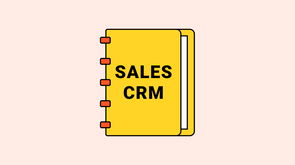Imagine spending thousands on a CRM but struggling to prove its value to stakeholders. Sound familiar?
Research shows CRMs can deliver up to an impressive 245% ROI, yet many businesses fail to measure it effectively.
This is because achieving these results goes beyond just investing in the software; instead, it requires understanding how to measure its impact and maximize its value.
In this blog, we'll break down:
- How to track/calculate the ROI of CRM?
- How to turn your CRM into a growth-driving asset?
Let's start by exploring the ROI of CRM.
What is CRM ROI?
CRM ROI is a metric that evaluates how much financial value your business gains from using a Customer Relationship Management system compared to what you invested in it.
Simply put, it answers the question: "Are we getting our money's worth from the CRM we've invested in?"
Calculating the ROI of CRM involves assessing the net profit gained from the CRM solution relative to its total investment cost.
The formula is shown below:
Let's break it down:
- Net gain from CRM: The total financial benefits your CRM has generated, such as increased revenue or cost savings.
- CRM investment cost: All costs associated with your CRM, including software, implementation, training, and ongoing maintenance.
Let's consider an example for better clarity.
Suppose a business invests $25,000 in CRM software and incurs $20,000 in additional costs for training and maintenance over two years, bringing the total investment to $45,000. During this period, the CRM generates $120,000 in extra revenue.
Using the CRM ROI formula:
CRM ROI = [(Net profit) / (Total investment)] x 100%
Net profit = $120,000 – $45,000 = $75,000
CRM ROI = ($75,000 ÷ $45,000) x 100% = 166.7%
This means the business gains $1.67 in profit for every dollar spent.
Note that Measuring the ROI of CRM helps you connect the dots between your spending and what you're getting in return.
Why is measuring CRM ROI important?
Understanding CRM ROI helps connect data and customer insights with business processes, enabling organizations to improve efficiency, enhance and manage customer relationships, and eliminate manual data entry bottlenecks.
Here's why it matters:
1. Justify costs
Stakeholders, especially in the C-suite, need data to support continued investments in technology. A solid ROI report can demonstrate how your CRM drives value and secures buy-in for future upgrades. For instance, a SaaS company justified upgrading its CRM after providing a 30% revenue boost.
2. Improve efficiency
ROI analysis reveals what's working. For example, automating follow-ups saved one business 10 hours weekly. Basically, the ROI evaluation is all about keeping your sales, marketing, and support teams running smoothly.
3. Enable continuous improvement
As your business evolves, so should your CRM. ROI tracking highlights areas to tweak for continued success.
Metrics to measure CRM ROI
These days, CRM has become a comprehensive solution for everything from marketing to sales to customer support.
We have presented the CRM ROI metrics around these departments; let's study them one by one:
CRM ROI metrics for sales
Your CRM should function as more than just a contact management tool. It should empower your sales team to work smarter and close deals faster.
Implementing a CRM solution can lead to significant sales improvements. Businesses have reported an average increase of 29% in sales revenue after adopting CRM solutions.
The following metrics reveal how effectively your CRM supports your sales strategy:







Key Takeaways
Imagine spending thousands on a CRM but struggling to prove its value to stakeholders. Sound familiar?
Research shows CRMs can deliver up to an impressive 245% ROI, yet many businesses fail to measure it effectively.
This is because achieving these results goes beyond just investing in the software; instead, it requires understanding how to measure its impact and maximize its value.
In this blog, we'll break down:
Let's start by exploring the ROI of CRM.
What is CRM ROI?
CRM ROI is a metric that evaluates how much financial value your business gains from using a Customer Relationship Management system compared to what you invested in it.
Simply put, it answers the question: "Are we getting our money's worth from the CRM we've invested in?"
Calculating the ROI of CRM involves assessing the net profit gained from the CRM solution relative to its total investment cost.
The formula is shown below:
Let's break it down:
Let's consider an example for better clarity.
Suppose a business invests $25,000 in CRM software and incurs $20,000 in additional costs for training and maintenance over two years, bringing the total investment to $45,000. During this period, the CRM generates $120,000 in extra revenue.
Using the CRM ROI formula:
CRM ROI = [(Net profit) / (Total investment)] x 100%
Net profit = $120,000 – $45,000 = $75,000
CRM ROI = ($75,000 ÷ $45,000) x 100% = 166.7%
This means the business gains $1.67 in profit for every dollar spent.
Note that Measuring the ROI of CRM helps you connect the dots between your spending and what you're getting in return.
Why is measuring CRM ROI important?
Understanding CRM ROI helps connect data and customer insights with business processes, enabling organizations to improve efficiency, enhance and manage customer relationships, and eliminate manual data entry bottlenecks.
Here's why it matters:
1. Justify costs
Stakeholders, especially in the C-suite, need data to support continued investments in technology. A solid ROI report can demonstrate how your CRM drives value and secures buy-in for future upgrades. For instance, a SaaS company justified upgrading its CRM after providing a 30% revenue boost.
2. Improve efficiency
ROI analysis reveals what's working. For example, automating follow-ups saved one business 10 hours weekly. Basically, the ROI evaluation is all about keeping your sales, marketing, and support teams running smoothly.
3. Enable continuous improvement
As your business evolves, so should your CRM. ROI tracking highlights areas to tweak for continued success.
Metrics to measure CRM ROI
These days, CRM has become a comprehensive solution for everything from marketing to sales to customer support.
We have presented the CRM ROI metrics around these departments; let's study them one by one:
CRM ROI metrics for sales
Your CRM should function as more than just a contact management tool. It should empower your sales team to work smarter and close deals faster.
Implementing a CRM solution can lead to significant sales improvements. Businesses have reported an average increase of 29% in sales revenue after adopting CRM solutions.
The following metrics reveal how effectively your CRM supports your sales strategy:
CRM ROI metrics for marketing
Your CRM is your marketing team's ally in understanding audiences, targeting efforts, and optimizing resources.
Marketing teams use CRM tools to analyze customer data, optimize automated marketing communication, and improve campaign ROI.
These metrics demonstrate its impact on marketing efficiency and effectiveness:
CRM ROI metrics for customer service
A great CRM doesn't just support sales and marketing; it's a critical tool for delivering exceptional customer experiences.
These metrics highlight how your CRM strengthens customer relationships:
Tracking all the above CRM ROI metrics will give deep clarity on the investment in customer relationship management software and sales growth optimization insight.
Get the insights you need to accelerate your sales
Track essential sales metrics like win rate, customer acquisition cost, and lifetime value to understand your growth.
Moving on to discuss how to calculate the ROI of CRM implementation.
How do you measure ROI in a CRM system: Step-by-step guide
The steps below are designed to give you actionable insights into your CRM performance.
Using a CRM ROI calculator alongside these steps can simplify the process and provide a clearer picture of how your CRM delivers value.
Let's dive in.
Step 1: Identify your gains
Start by asking yourself: What has my CRM helped us achieve? Your gains might not always jump out, but they're there—often in areas like:
💡 Pro tip: Break these down into measurable numbers. For example, if your team saves 20 hours a week due to automation, calculate the dollar value of those hours.
Step 2: Calculate your investment
This part is straightforward but often underestimated. Add up everything you're spending to keep your CRM running, such as:
🎯 Practical insight: Don't forget hidden costs, like your team's time learning the system. It all adds up.
Step 3: Apply the formula
Now comes the math, so don't worry; it's simple.
Use this formula:
CRM ROI = ((Total Gains - Total Investment) / Total Investment) × 100
Here's an example for you:
CRM ROI = ((100,000 - 40,000) / 40,000) × 100 = 150%
For every dollar you've invested in your CRM, you've earned $1.50 in return.
Step 4: Interpret the results
The number is important, but the insights behind it are what matters.
Here's how to make sense of your ROI:
Leverage these ROI insights to refine strategies for improving sales revenue, enhancing customer data utilization, and reducing training costs.
Ready to work smarter, not harder?
Automate your sales, marketing, and follow-ups with Salesmate, and focus on what truly drives growth—your customers.
5 Proven strategies to maximize the ROI of CRM
The following strategies can help turn your CRM into a powerful tool for driving measurable outcomes, improving team productivity, and enhancing customer experiences.
Let's explore actionable, proven methods to maximize your CRM ROI.
1. Boost user adoption
Teams that understand the full capabilities of a CRM are more likely to use it consistently, directly impacting efficiency and results.
You can begin by focusing on:
Teams that understand the full capabilities of a CRM are more likely to use it consistently, directly impacting efficiency and results.
2. Automate repetitive tasks
Automation saves time and ensures accuracy and consistency, allowing your team to focus on value-adding activities.
Use your CRM to automate:
3. Integrate with other tools
Integrations create a unified view of your business, helping you make smarter decisions and eliminate inefficiencies across departments.
For instance, connecting your CRM with professional services automation platforms ensures seamless workflows and better data and customer insights.
Consider integrating with:
A well-integrated CRM ensures seamless coordination between teams, improving product or service delivery efficiency and enhancing overall customer satisfaction.
4. Maintain clean data
Your CRM is only as reliable as the data it holds. Further, data quality improves decision-making and ensures that your CRM insights are actionable and trustworthy.
Prioritize regular data hygiene to:
5. Monitor performance
Performance monitoring keeps your strategies on track and highlights areas where adjustments are needed to achieve optimal results.
Set up real-time dashboards to track:
Challenges in measuring CRM return on investment
Businesses often encounter roadblocks that can cloud their understanding of the value their CRM delivers.
Let's discuss some key common challenges and practical solutions to overcome them.
1. Poor user adoption
If your team isn't fully on board with using the CRM, measuring its true value is nearly impossible. Lack of proper training or a system that feels too complex can lead to underuse and missed opportunities.
What you can do:
2. Fragmented data
Does your CRM feel like an island, disconnected from the rest of your business tools? When data is scattered across systems, it's hard to accurately see the complete picture or track ROI.
How to fix it:
3. Unrealistic expectations
Expecting a CRM to deliver instant results can set you up for disappointment. Implementing, training your team, and refining your processes takes time before the true impact shows.
The better approach:
Invest in a CRM that fits your business like a glove
Salesmate lets you customize your CRM to fit your exact needs, helping your team work smarter and scale faster.
Wrap up
Your CRM should do more than track data. It should drive results and deliver real value. With a clear understanding of what ROI metrics to track, you can stop wondering if your CRM is worth it—start proving it.
Salesmate redefines ROI by offering features that save money, enhance productivity, and simplify processes. With its customizable workflows, automation tools, and built-in integrations, it eliminates the need for costly add-ons while delivering everything your business needs in one platform.
The result? Streamlined operations, smarter decisions, and more revenue without overspending.
If you're ready to turn your CRM into a growth-driving asset, Salesmate is here to help. Experience Salesmate with a 15-day free trial and unlock real ROI.
Frequently asked questions
1. What does CRM stand for?
CRM stands for Customer Relationship Management. It's a strategy and technology combined to manage and analyze customer interactions throughout their lifecycle, aiming to improve business relationships, retain customers, and drive sales growth.
2. Are CRMs worth the investment?
Investing in a CRM is generally considered worthwhile. Beyond financial returns, CRMs enhance customer satisfaction, improve sales productivity, and provide better sales forecasting accuracy.
3. How long does it take to see CRM ROI?
Most businesses observe a return on their CRM investment within 12 to 18 months. This timeframe can vary based on user adoption rates, the complexity of implementation, and how effectively the CRM is utilized.
4. What factors influence CRM ROI?
Key factors that impact CRM ROI include:
5. Is ROI only about revenue?
No, ROI encloses both financial and non-financial gains. Beyond revenue, it includes:
6. What's considered a "good" ROI for CRM?
A strong CRM ROI is typically considered a $5 to $30 return for every $1 spent. This range reflects the varying impacts of CRM systems across different industries and implementation strategies.
7. How do I measure non-financial ROI?
To assess non-financial ROI, monitor metrics such as:
Sonali Negi
Content WriterSonali is a writer born out of her utmost passion for writing. She is working with a passionate team of content creators at Salesmate. She enjoys learning about new ideas in marketing and sales. She is an optimistic girl and endeavors to bring the best out of every situation. In her free time, she loves to introspect and observe people.